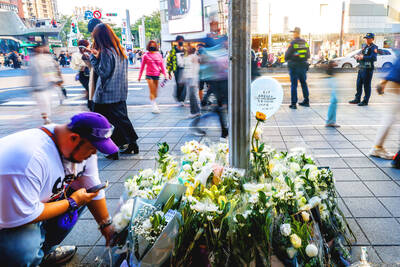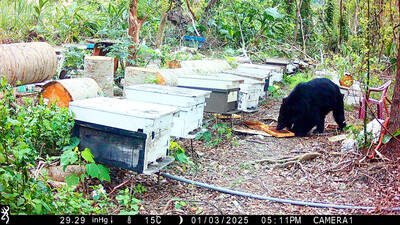A youth foundation yesterday launched a cross-strait astronomy camp, with junior high school students from Beijing joining their counterparts in Taiwan for a week of cultural exchange and study of the heavens.
The Tosun Public Interest Foundation, an organization that deals with youth issues, organized the program, in which 20 students from China and 40 from Taiwan will participate in the week-long camp and tour the nation.
The camp officially begins tomorrow and will last until Friday.
Liao Cheng-hao (廖正豪), the foundation's director, said that the astronomy camp will take place on Alishan and Yushan, where there are clear skies that offer an excellent view of planets and stars.
Liao said that the camp was a rare opportunity for youth from both sides of the Taiwan Strait to meet and learn from one another.
Foundation vice executive director Viviane Tien (
Jing Hairong (
Jing said that the Chinese students will share what they learned in Taiwan with other students upon their return to Beijing.
Liu Ge, an eighth-grade student and member of the astronomy club of Beijing's Jingshang Middle School, said it was her first visit to Taiwan, and that she was excited to learn about the students here as well as view the heavens from Taiwan.
Miao Jun (
A representative from the Taipei astronomical museum, Chiang Chung-jen (江崇仁), said that astronomical education in Taiwan consisted of just a few science classes at school, which only covered the basics. Schools should do more to emphasize astronomy, Chiang said.

SHIPS, TRAINS AND AUTOMOBILES: The ministry has announced changes to varied transportation industries taking effect soon, with a number of effects for passengers Beginning next month, the post office is canceling signature upon delivery and written inquiry services for international registered small packets in accordance with the new policy of the Universal Postal Union, the Ministry of Transportation and Communications said yesterday. The new policy does not apply to packets that are to be delivered to China, the ministry said. Senders of international registered small packets would receive a NT$10 rebate on postage if the packets are sent from Jan. 1 to March 31, it added. The ministry said that three other policies are also scheduled to take effect next month. International cruise ship operators

HORROR STORIES: One victim recounted not realizing they had been stabbed and seeing people bleeding, while another recalled breaking down in tears after fleeing A man on Friday died after he tried to fight the knife-wielding suspect who went on a stabbing spree near two of Taipei’s busiest metro stations, Taipei Mayor Chiang Wan-an (蔣萬安) said. The 57-year-old man, identified by his family name, Yu (余), encountered the suspect at Exit M7 of Taipei Main Station and immediately tried to stop him, but was fatally wounded and later died, Chiang said, calling the incident “heartbreaking.” Yu’s family would receive at least NT$5 million (US$158,584) in compensation through the Taipei Rapid Transit Corp’s (TRTC) insurance coverage, he said after convening an emergency security response meeting yesterday morning. National

PLANNED: The suspect visited the crime scene before the killings, seeking information on how to access the roof, and had extensively researched a 2014 stabbing incident The suspect in a stabbing attack that killed three people and injured 11 in Taipei on Friday had planned the assault and set fires at other locations earlier in the day, law enforcement officials said yesterday. National Police Agency (NPA) Director-General Chang Jung-hsin (張榮興) said the suspect, a 27-year-old man named Chang Wen (張文), began the attacks at 3:40pm, first setting off smoke bombs on a road, damaging cars and motorbikes. Earlier, Chang Wen set fire to a rental room where he was staying on Gongyuan Road in Zhongzheng District (中正), Chang Jung-hsin said. The suspect later threw smoke grenades near two exits

The Forestry and Nature Conservation Agency yesterday launched a gift box to market honey “certified by a Formosan black bear” in appreciation of a beekeeper’s amicable interaction with a honey-thieving bear. Beekeeper Chih Ming-chen (池明鎮) in January inspected his bee farm in Hualien County’s Jhuosi Township (卓溪) and found that more than 20 beehives had been destroyed and many hives were eaten, with bear droppings and paw prints near the destroyed hives, the agency said. Chih returned to the farm to move the remaining beehives away that evening when he encountered a Formosan black bear only 20m away, the agency said. The bear